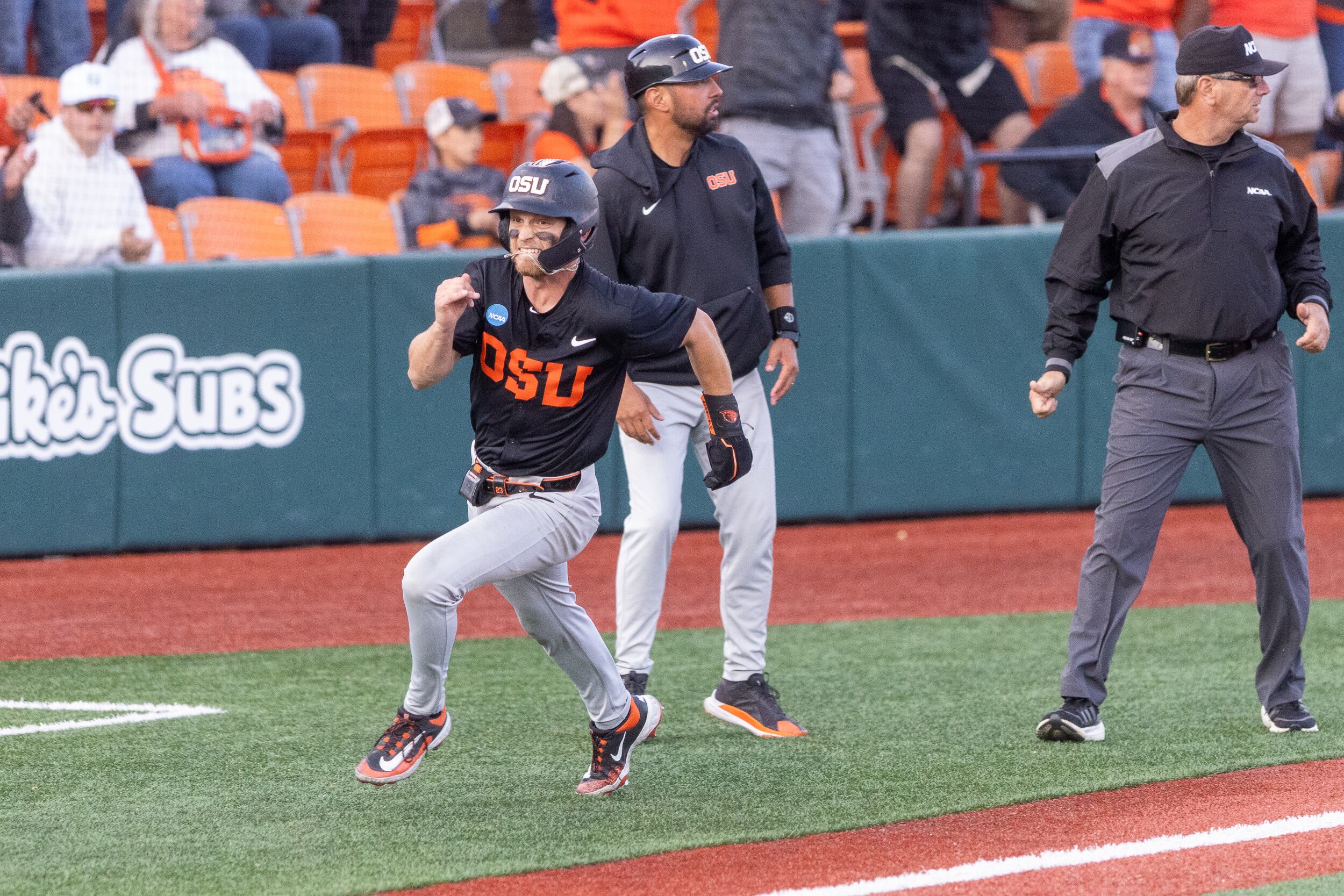Lost Tracks Golf Club in Bend
Published 12:00 am Monday, June 23, 2014

- Andy Tullis / The BulletinFrank Spernak of Bend, tees off on hole 17 while playing at Lost Tracks Golf Club in Bend Wednesday morning 6-18-14.
Standing on the first tee at Lost Tracks Golf Club, my playing partner looked bewildered as he stared down the fairway that turns hard right some 250 yards away.
He observed that any glimpse of the green was completely obscured by towering ponderosa pines.
Trending
My parter, with whom I was randomly paired, was a vacationer from Sacramento, Calif. He immediately asked if I had ever played Lost Tracks before as he contemplated the proper route to the hole.
I assured him that I had and gave him a piece of advice: “Choose the right tee so you can comfortably reach the corner of all the doglegs and you’ll be fine.”
A little course knowledge always helps, but it is especially helpful on Lost Tracks — and its 14 dogleg holes.
On this mild, sunny afternoon, the value of familiarity at Lost Tracks was made clear to me. I now actually quite enjoy the southeast Bend course, something I would not have said the first time I played it six years ago.
The evolution in my opinion of Lost Tracks did not surprise Brian Whitcomb, who owns and designed Lost Tracks.
“If you went out immediately after your first round and played your second round, you would have probably played a whole lot better,” said Whitcomb, who also served as president of the PGA of America (2007-08). “But secondly, we’ve done a lot of things to enhance your experience, too.”
Trending
Whitcomb noted that he designed all those doglegs for several reasons. One, he likes that doglegs force golfers to think about proper angles of attack. Two, he wanted a course with mountain views. Finally, he had to build the course around numerous lava outcroppings and on a limited budget.
But Lost Tracks has made a number of changes over the years that have improved the way the course plays, particularly for lesser-skilled golfers.
Examples of the tweaks include an additional bunker that protects the right corner of the 432-yard third hole where the fairway turns right. Lost Tracks also repositioned the tee box on the 458-yard par 4 for all but the back tee to flatten the angle of the hole.
More than that, though, the course has widened the target areas on most holes to be a more forgiving course.
“If you are going to shoot a low score at Lost Tracks, you have to hit the ball in the same place you did 15 years ago,” Whitcomb said. “However, if you are going to shoot a modest score, you can hit a whole bunch more places today than you could 15 years ago.”
The improvements must have worked.
“As we softened the golf course through the years, we don’t hear what we used to hear,” Whitcomb said of the complaints about the doglegs.
In fact, the most trouble a golfer can find at Lost Tracks is the result of not properly considering the entire hole.
On a day when I played with plenty of control, I got careless on the par-5 seventh hole, a 60-degree dogleg left. At 457 yards from the tournament tees (which play at 6,401 yards), I chose to go for the green in two shots.
I teed off with a 3-wood, and my shot drifted slightly right and my ball ran through the fairway and into a brutal lie in some native grass. That forced me to punch out. But worse yet, by sitting too far right, my angle to the green was almost entirely cut off by trees and more rough.
Still, I had a par save on my mind and tried to cut a 2-hybrid some 215 yards. A poor choice.
My shot did not cut, and instead it landed in a rock outcropping just left of the green, a prison that took me two swings to escape.
After playing the first six holes at 2 over par, I made an 8.
The thing is, I deserved that snowman. In fact, not once through my round at Lost Tracks did I feel as if I scored anything other than what I deserved. That is a testament to the course’s fair design.
Or, as my playing partner put it as we walked to the 18th tee: “This is actually a very playable golf course. If you hit it well, it rewards you.”
Difficulty of course
Despite 14 doglegs — some with modest turns while others turn at nearly a full right angle — Lost Tracks is actually quite playable for golfers of most skill levels.
The fairways are wide enough to forgive moderate mis-hits, and the target areas are plain to see from the tee. However, golfers who spray the ball off the tee might find themselves playing tough shots with awkward angles around ponderosa pines.
The green complexes are heavily guarded by bunkers, but with only one forced carry over water (the signature par-3 16th hole), novices should be able to make their way around the course.
Favorite hole
With its island green, the signature 172-yard 16th hole is the most memorable on the course. But finishing with a risk/reward par 5 makes for a tremendous end to a round, especially if a golfer has ground to make up at the end of a match.
The 524-yard 18th hole at Lost Tracks is a sharp dogleg left that entices golfers to cut the corner and play for the green in two shots, but trouble lurks for the overly aggressive. A well-struck drive that drifts too far right of the intended target could run into a water hazard that protects the right side of the fairway.
Golfers who hit a solid drive have the opportunity to hit a challenging approach shot into a green placed left of the fairway. That shot is made even more difficult by three deep bunkers guarding the right side of the green that close off the ideal bailout area.
How to approach the course
With doglegs present to some degree on every hole except the par 3s, the key to scoring well is creating the proper angles around the turns to attack the greens. This requires a golfer to think his or her way around the course rather than just grabbing driver and hoping for the best.
Choosing the right tee is of paramount importance (Lost Tracks has four sets of tees set at 7,003, 6,401, 6,073 and 5,344 yards). Play the course at a tee too long and you will be fighting the doglegs. Pick a tee too short and you can forget about hitting a driver.
Bunkers, which are filled with a particularly fluffy sand, typically guard the greens. Those putting surfaces are also often significantly sloped, putting a premium on accuracy with approach shots.
Off the course
The indoor/outdoor training facility run by longtime Lost Tracks teaching pro Bob Garza at one end of the course’s modest driving range is among the best-equipped in the region.
A short-game practice area is located near the range, and the practice putting green is just a few steps away from the first tee.
The collection of golf memorabilia — most of which is from Whitcomb’s term as executive for the PGA of America — makes the pub a must visit for anyone who appreciates the professional game. And Whitcomb regularly rotates the items displayed.
Verdict
Lost Tracks has grown on me over the years, and I now consider it among the upper tier of Central Oregon’s daily-fee facilities.
Its $74 peak weekend rate, which includes golf cart, is comparable to similar daily-fee courses in the region. The course offers significant discounts later in the day, dropping to $49 at noon.
The bottom line is that Lost Tracks is a worthy play for any golfer who wants to play a well-maintained position golf course.
— Reporter: 541-617-7868, zhall@bendbulletin.com.
Editor’s note: This is another installment in a seasonlong series in which Bulletin golf writer Zack Hall visits each public and semiprivate golf course in Central Oregon.








